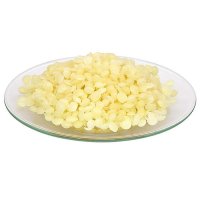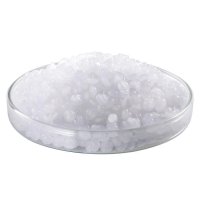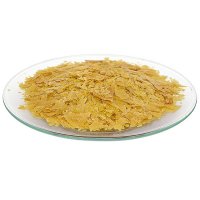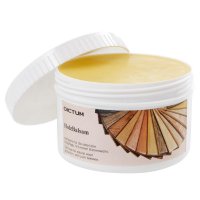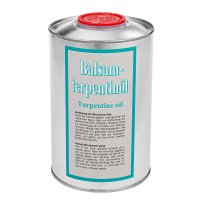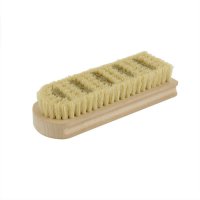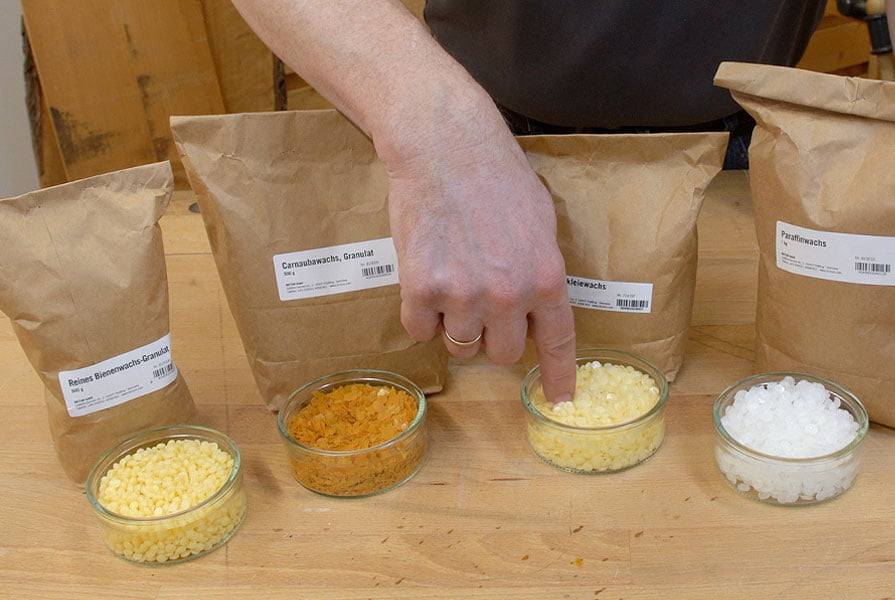
They can be used in many ways in the woodworking shop. With different waxes and wax mixtures, surfaces can be protected, defects can be repaired and materials can be joined or separated. In this article, we would like to take you into the interesting world of waxes.
What types of wax are there?
The world of waxes is complex and not exactly defined. There are numerous groups of substances that behave like waxes and often occur as mixtures. In general, substances are called waxes if they have a strongly temperature-dependent consistency and solubility, are kneadable at room temperature (20 °C), solid to brittle-hard, melt above 40 °C and become slightly liquid above the melting point (low viscosity), can be polished under slight pressure and are translucent to opaque in colour but not glassy. To present all waxes here would go beyond the scope of a blog post. We would therefore like to introduce you to the most important waxes for everyday use in the wood workshop. Roughly, waxes can be divided into the following groups:
Animal waxes
Animal waxes include wool wax (lanolin) and China wax (secretion of the wax scale insect). Shellac also contains parts of wax, but these are removed because they reduce the quality.
Beeswax. is probably the most used animal wax in woodwork. The yellowish, soft wax has a relatively low melting point of 61 to 68 °C. It is used as a traditional polishing agent. It is used as a traditional polish and wood preservative for silky, shiny, hard-wearing surfaces. The excretory product of honey bees has long been used for the care and preservation of wooden surfaces and as a putty and adhesive. In its pure form, it is processed as a solid ingot or melted, or used in mixtures with alcohol or oil and other additives. Outside the carpenter's workshop, it is popular for making candles and is used in the food industry as a release agent and coating agent (E901) as well as in cosmetics, pharmaceuticals, and soaps.
The putty wax of honey bees, known as Propolis, makes varnishes and oils more supple and durable and gives them a pleasant scent. Due to its disinfecting effect, propolis prevents bacterial or fungal infestation without having any physiologically harmful side effects. This makes it ideal for treating wooden parts that come into contact with the skin, such as cooking utensils, sauna, and bathroom furniture or children's toys. It is either dissolved directly in varnish or oil or further processed with high-percentage spirit into a liquid concentrate. Propolis is also used to simulate the typical smell of beeswax stretched with paraffin or stearin.
Vegetable waxes
Many plants protect themselves from water loss and pests by a wax layer on leaves and fruits. These waxes are usually obtained as a by-product during further processing. Plant waxes include, for example, sugar cane wax, coconut wax, flax wax and cotton wax.
Für besonders verschleißfeste, glänzende Polituren und auch als Schmiermittel bei gleitenden Holzteilen sowie als Korrosionsschutz auf Metallflächen ist Carnauba Wax is suitable for particularly wear-resistant, shiny polishes and also as a lubricant for sliding wooden parts and as corrosion protection on metal surfaces. The wax of the Brazilian carnauba palm is characterized by high hardness and good physiological compatibility. The hard wax is mostly unbleached, its melting point is approx. 90 °C. Das Wachs der brasilianischen Carnaubapalme zeichnet sich durch hohe Härte und gute physiologische Verträglichkeit aus. Das harte Wachs ist meist ungebleicht, sein Schmelzpunkt liegt bei ca. 90 °C.
Reiskleiewachs (Rice Bran Wax (Oryza Sativa Bran Wax)) is an excellent binder for oils and for oil/wax mixtures. In complex processes, the wax is obtained as a by-product from pure rice oil (contains only approx. 4 to 6% wax), which is produced for food and cosmetics production. The exceptional combination of high hardness and excellent miscibility make it a valuable ingredient for wear-resistant ecological surface agents without additives (emulsifiers). Melting point 77 to 82 °C.
Mineral waxes
They essentially consist of hydrocarbons. These include microcrystalline waxes such as petroleum wax and vaseline (petrolatum), which are used e.g., for lubricants and shoe polish.
Paraffin Waxes are a product of lubricating oil refining. They are produced during the further processing of base oils. They are hard and brittle and have a low viscosity in molten form. Hard paraffin melts between 50 and 60 °C, soft paraffin at about 45 °C. Applications include candles, adhesives, sealants, rubbers, paints and varnishes, printing inks, cosmetics, pharmaceuticals, paper, and food. In the workshop, the transparent wax is often used to seal end-grain wood surfaces, as a block for direct application in woodturning, melted for mixing with beeswax, as a preservative for wood & metals and for lubricating sliding couples (e.g., wooden threads).
Synthetic and semisynthetic waxes
Synthetic waxes are obtained by pressure, polymerization, condensation or addition, mainly from petroleum or also lignite. A typical representative is the so-called ski wax. Semisynthetic waxes, on the other hand, are obtained from natural waxes, oils, and fats. Their composition is determined by physical or chemical transformations such as oxidation (bleaching), hydrogenation, esterification, or saponification.
Stearin, for example, is mainly obtained from vegetable palm oil or animal fat and is therefore biodegradable. Stearin was discovered as a suitable candle raw material in 1818. The melting range of stearin is between 55 and 70 °C, depending on its composition. It is used, among other things, as a raw product in soap production. Stearin is also used as an additive in industrially applied lubricants to increase the separability. Stearin is used together with beeswax to produce candles. The remains of stearin candles, which contain only natural or nature-identical colouring agents, can be composted.
The waxes mentioned often have very different, sometimes contradictory properties. For example, waxes can be used both as an adhesive and as a release agent. In the following, we would like to present practical applications of waxes in the workshop.
Wax for markings
Wax has good to very good adhesion on most surfaces, which makes it excellent for marking on difficult, very smooth or rough surfaces. In carpentry, wax pencils are therefore used to mark rough cutting on unplaned boards and planks. Due to its high wax content, the Lyra Wax Pencil »Garden Pen«, for example, is also suitable for damp surfaces in the garden, for carpentry and for outdoor activities. The advantages of wax pencils: they do not run, the wax remains on the surface of the wood and can therefore be easily removed again, and they are usually waterproof.
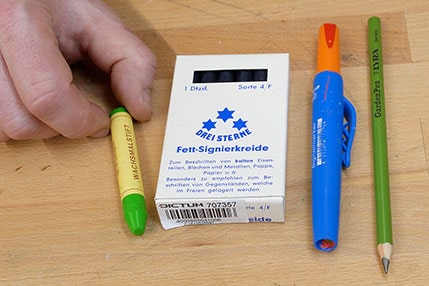
Due to their high adhesion, wax markers write on almost all surfaces.
Wax as an adhesive
The adhesion strength just mentioned also makes wax a versatile adhesive. It is therefore often used as a »hot melt« adhesive for food packaging and laminates. In the workshop, for example, you can use small wax adhesive plates (for candles) as a temporary connection of small parts.
When sewing leather or the classic saddler's seam, the threads are waxed with beeswax. On the one hand, this serves to glue the fibres together, making the thread more durable and less likely to break. On the other hand, the thread is knotted in the saddler's seam and the knot is glued together by the wax so that the seam will still not come undone if damaged.
Wax as a sealant
The so-called »sealing wax«is well known. In contrast to hard sealing wax (usually shellac mixtures), it is soft and flexible and therefore withstands mailing much better. Such sealing wax is also used to seal wine bottles or corks to minimize the risk of oxidation of the wine by penetrating atmospheric oxygen. In the wood workshop, paraffin wax is mainly used to seal end-grain surfaces when storing wood. Without a layer of wax, the wood dries faster on the end faces than on the longitudinal cuts, which leads to cracking. Anchorseal. is particularly easy to use. This wax emulsion can be brushed or sprayed on directly without heating and prevents 90% of end-grain cracks (dry cracks) on freshly cut logs, sawn timber and turning and carving blanks.
Wax as a lubricant and separating agent
To make wooden drawers run more smoothly, you can rub the running surfaces with a little paraffin wax. To achieve this, simply rub the bottom edges of the drawer and the runners with a block of paraffin wax.
Screws can also be screwed in more easily if you first apply a little wax to their tips. Especially with small, soft brass screws, such as those used for so-called casket hinges, this helps to prevent the screw head from turning off.
With wood and metal planes, Planing Wax reduces the resistance between the sole of the plane and the workpiece. For metal planes, it also serves as a rust protection with a preservative long-term effect. Unlike other waxes, it does not affect the application of stains, oils, or varnishes and can be applied directly without heating (temperature range from -10 °C to +270 °C).
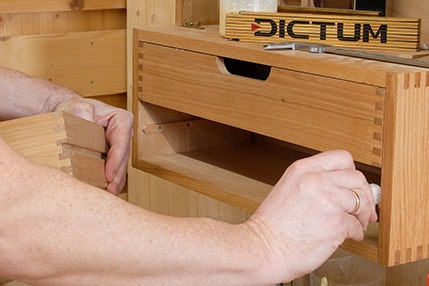
A little wax on the runners makes the drawer run smoothly
Wax is also very helpful as a release agent when gluing. Normal wood glue will not adhere to add-ons and inserts that have been waxed beforehand. For larger surfaces (veneer presses) and metal clamps, the silicone-free wax emulsion BATES is particularly suitable. This release agent for cold glue applications can be easily applied with a cloth, brush, sponge, or spray bottle. Clamps, presses, and machines are protected from glue deposits. The time spent cleaning clamps and presses is significantly reduced. With regular use, you no longer need aggressive cleaning agents to remove glue residues.
Waxes for surface treatment
Waxed surfaces have many advantages. They are breathable and at the same time protect the wood against fluctuating humidity. Depending on the desired appearance, you can create matt surfaces or polish the wax to a silky sheen. Surfaces treated with wax are well protected against water, feel pleasantly warm (haptics) and can be easily repaired or re-waxed.
Pure Beeswax is often used for the surface treatment of wood. It is used in its pure form as a solid wax, mixed with Turpentine Oil as a "soft wax" and as a component of wax mixtures and polishes. In our Surface Primer, you will find numerous recipes and application examples for wax mixtures, not only with beeswax.
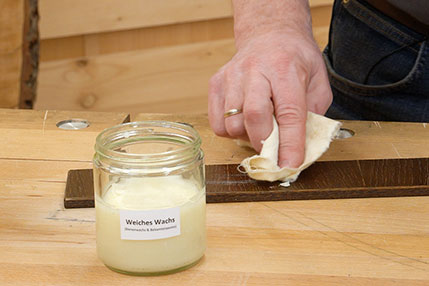
This mixture of beeswax and turpentine oil is easy to apply.
If you prefer not to mix it yourself, you can use ready-made wax mixtures from our range. DICTUM HolzBalsam is a fragrant mixture of beeswax, carnauba wax, linseed oil, tung oil and orange oil. The balm not only cares for and preserves wood, it can also be applied excellently to cork surfaces, smooth leather and metal and protects them from moisture.
The wax of the bearberry (Arctostaphylos uva-ursi) makes Kirjes Natural Oil Wax one of the highest quality organic wood preservatives. The Swedish oil wax emphasizes the grain of the wood and protects against moisture and dirt. Other ingredients are beeswax and Swedish linseed oil. So-called decorative waxes are suitable for effective surfaces. These are usually based on a mixture of beeswax and carnauba wax with various pigments. Antique Wax is intended for achieving antique effects and creating a dark patina. With stained and glazed surfaces, it gives furniture a realistic aged effect. To simulate a limed surface on open-pored woods such as ash or oak, their surface is brushed, stained or oiled and then treated with lime wax. The Lime Wax is rubbed into the open pores. Depending on the desired effect, the surfaces are then polished free or retain a light layer of lime wax. With coloured Decorative Wax, you can similarly achieve a so-called "vintage look" on furniture and decorative objects.
When a surface is damaged or scratched, the carpenter likes to reach into his "wax box". Because almost every wood professional has a hard wax assortment for touching up. These are hard wax sticks (like sealing wax) in different wood shades, which are rubbed on directly or melted with a kind of soldering iron in the case of minor scratches. By combining several shades, the wood grain can be perfectly imitated, and the scratches are hardly visible any more.

